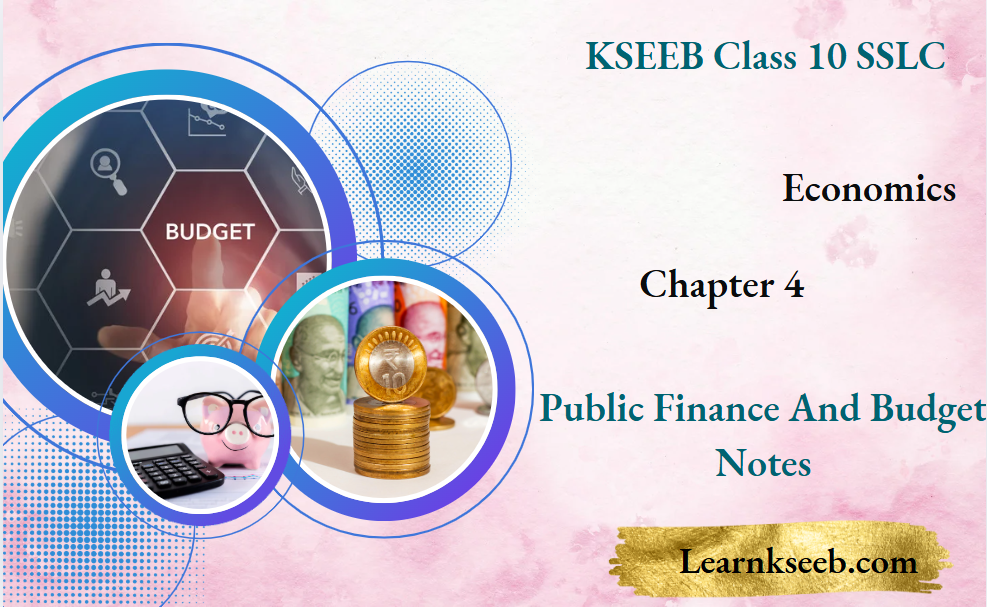KSEEB Class 10 SSLC Economics Chapter 4 Public Finance And Budget Notes
Meaning of Public Finance and its Importance
- Each family earns its income by working in jobs in the agricultural, industrial or service sector.
- Balancing the income and expenditure by an individual or a family and thereby achieving progress, is an art.
- When the expenditure is more than the income, it leads to debt.
- ‘Personal Finance’ deals with the kind of income, expenditure and debt management of an individual.
“KSEEB Class 10 Economics Public Finance and Budget notes”
- In the same manner, the government manages its finance. It is called ‘Public Finance’.
- The government manages public finance according to fiscal policy.
- Developing countries like India utilizes public finance in order to eradicate poverty and unemployment, regulate financial upheavals and commodity prices, and thereby establish financial stability.
- In India, the financial year starts from 1st April and ends on 31st March of the successive year.
Budget
- The statement of estimated income and expenditure of a year prepared by the government is called Budget.
- The central and state governments present their own budgets.
Every year, the government presents a budget in both the Houses in February or March.
“Class 10 Karnataka Board Economics Chapter 4 notes”
- Through this budget, the government tries to achieve the objectives of its fiscal policies.
- In India, the Central budget is prepared by the Finance Minister in consultation with the finance department.
- The Finance Minister introduces the Central budget in the Lok Sabha in February or March.
- Budgets are of three types: Surplus Budget, Deficit Budget and Balanced Budget.
- In India, the government normally presents a deficit budget and tries to achieve economic progress.

Public Expenditure and Public Income
- The government spends money for various purposes like defence, administration, economic development and welfare of the people. This is called Public Expenditure’.
- The expenditure of the Central Government is of two types: Revenue Expenditure and Capital Expenditure.
- Revenue expenditure is classified into two groups: Planned Expenditure and Non-planned Expenditure.
- The government spends money on administration, national economic development and citizen’s welfare.
- Under the Central Planned Expenditure, the government spends money on three types of services and development.
- They are: Financial Services, Social Services and General Services.
- The government collects income from varied sources for its expenditure. This is called ‘Public Revenue’.
“SSLC Economics Chapter 4 Public Finance and Budget explained”
- The Central Government collects its income from various sources. These sources can be classified under two heads as Revenue Receipts and Capital Receipts.
- The money paid by the citizens without any expectation in return is called tax.
- Taxes are the major sources of revenue for the government.
- The principle used by the government in the imposition of taxes is called Principle of Progressive Taxation.
- The taxes imposed by the Central Government are of two types: Direct Taxes and Indirect Taxes.
- The main types of Direct Taxes are: Personal Income Tax, Corporate Tax, Wealth Tax, Stamp Duty, etc.
- The main forms of Indirect Taxes are Central Excise Duty, Import-Export Taxes, Service Tax and Foreign Travel Tax, etc.
- Through taxation, the government aims at increased revenue collection.
- Apart from taxes, the government generates revenue from other sources. This is called Non-Tax Revenue.
- The revenue generated by the government which is intended to be used to create new properties in various fields of the economy, is called Capital Receipts.
Deficit Finance and Fiscal Deficit
- The government generates the capital revenue mainly through loans from internal and external sources.
- The loan obtained from citizens of the country, banks, financial institution and industries is called internal debt.
- The loan obtained from foreign governments and foreign financial institutions is called foreign debt.
Apart from taking loans, the government generates capital revenue from other sources too.
“KSEEB SSLC Public Finance and Budget chapter summary”
- Government withdraws its investment in public industries. This is called disinvestment.
- The money obtained through disinvestment and repayment of loans is called non-debt capital receipts.
- According to the definition of the Indian Planning Commission, deficit financing is ‘improving the net purchasing power in the economy through the budgetary provisions of the government.
- The deficit is indicated by the negative sign (-).
- There are four kinds of Deficit Financing: Revenue Deficit, Tax Deficit, Fiscal Deficit and Primary Deficit.
- When the government is not able to overcome the fiscal deficit even after taking loans, the Reserve Bank of India gives loans to the government in the form of printing notes and putting them into circulation.
- Fiscal deficit can be shown in the form of a formula in this manner:
- Fiscal Deficit = (Revenue Receipts + Non-debt Capital Receipts) – Total Expenditure.
KSEEB SSLC Class 10 Biology Notes Karnataka State Syllabus
Chapter 1 Life Processes Notes
Chapter 2 Control and Coordination Notes
Chapter 3 How Do Organisms Reproduce Notes
Chapter 4 Heredity and Evolution Notes
